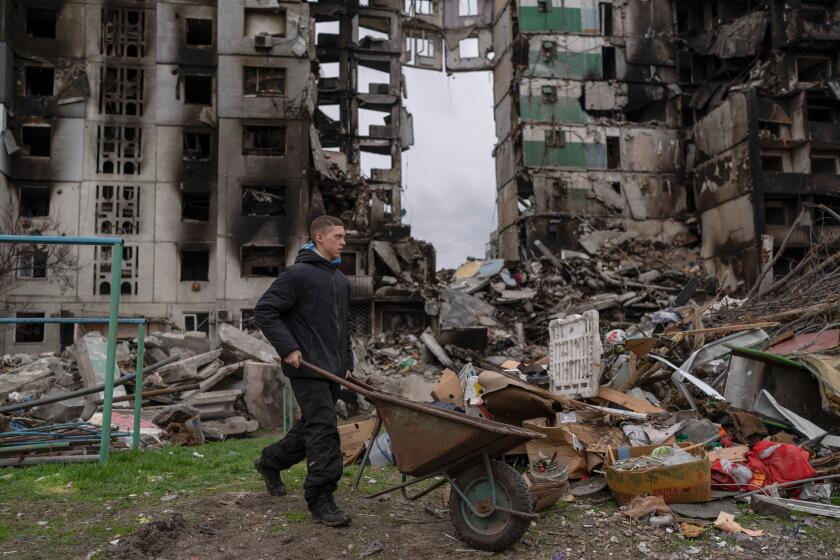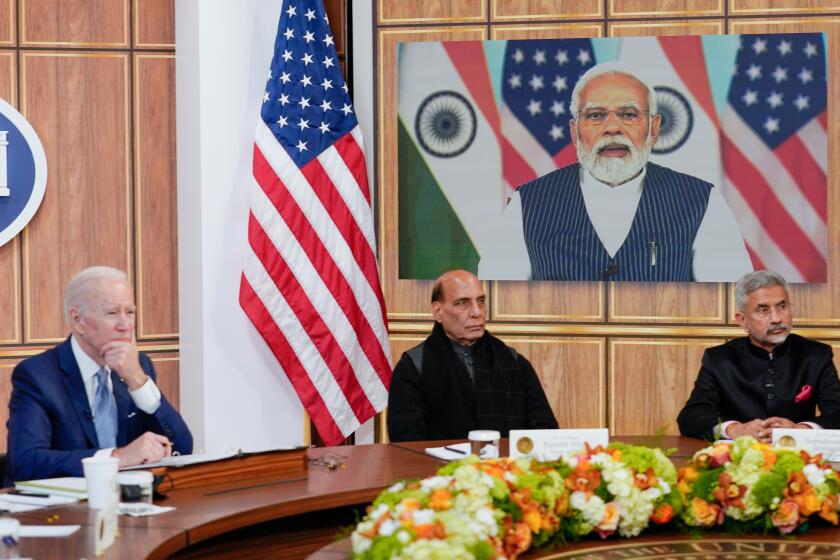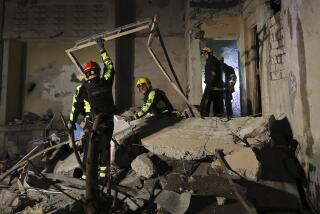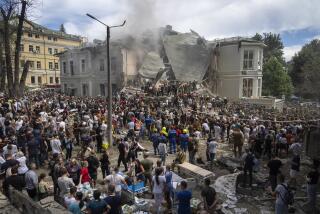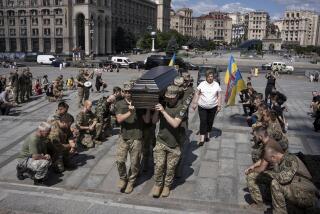‘Why did Putin do this to us?’ A battered Ukrainian city emerges from a siege
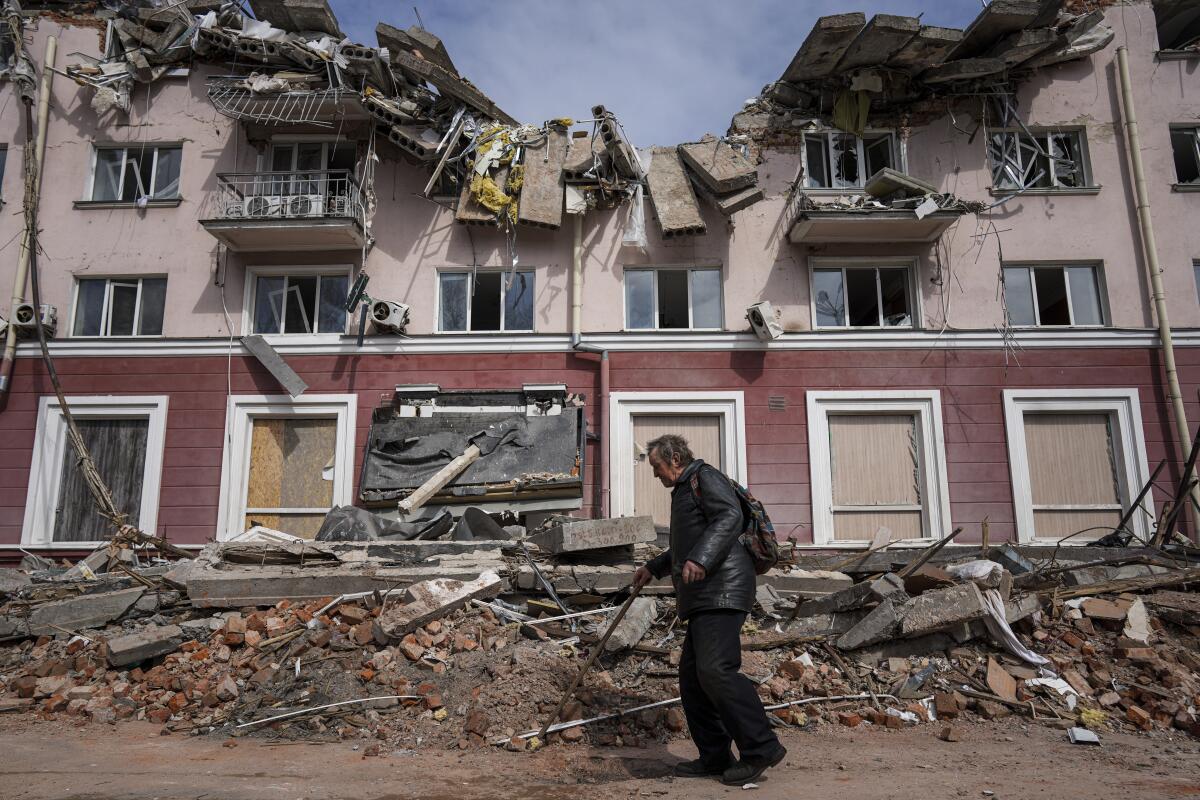
- Share via
CHERNIHIV, Ukraine — It was a brilliant, sunny day in this industrial city in northeastern Ukraine. The bombs started falling along Chornovola Street around noon.
Witnesses spoke of five or six blasts that day, March 3. The lucky ones made it to basement shelters. Many did not.
“Why did Putin do this to us?” asked Valentina Artiukh, 68. “We weren’t bothering him, we weren’t bothering anybody. We were just trying to live our lives. Normal.”
Russian President Vladimir Putin is far from done. But as his troops prepare for a new offensive, the veil of war in Ukraine has started to lift in the places they have now abandoned. Their retreat has revealed brutality on a massive scale.
In the northern suburbs of Kyiv, the capital, the Russian pullback has bared evidence of atrocities in towns like Bucha, now infamous worldwide for streets and fields littered with the remains of apparent victims of execution.
Here in Chernihiv, a city some 55 miles from the Russian border, nearly 200,000 people fled before or shortly after the Russian invasion began on Feb. 24. The 100,000 or so who remained — many of them elderly — endured a 38-day siege.
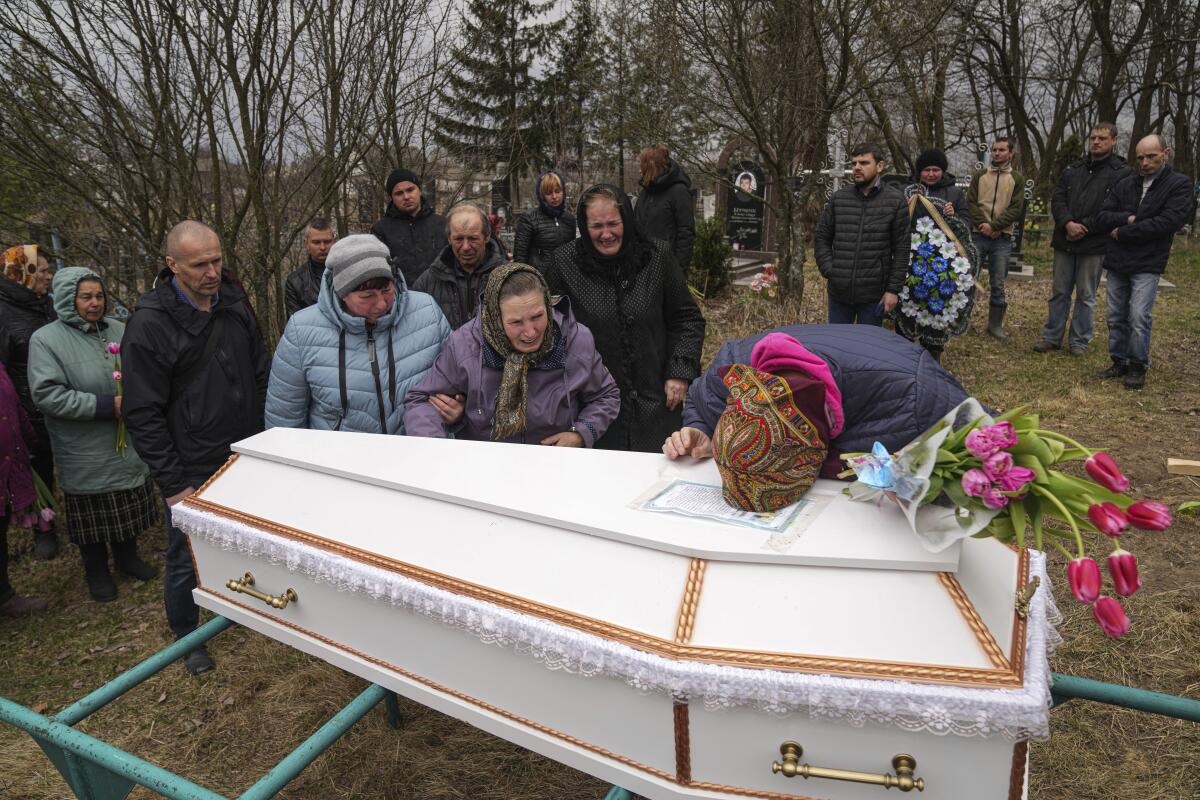
“We wouldn’t let the Russians destroy us,” Alexander Lomako, secretary to the city council, told visiting journalists on Monday, recounting how doctors continued treating patients in bomb-damaged hospitals lacking electricity.
Russian forces never occupied the city, but they nearly encircled it. Ukrainians risked their lives to smuggle in supplies by road or on boats via the Desna River.
More than 10,000 civilians have been killed in Mariupol, as Russians use mobile cremation equipment to conceal war crimes, a city official says.
Moscow appeared content to keep Chernihiv in check, its defenders tied down, while a major contingent of Russian forces advanced toward Kyiv, 50 miles to the south.
Aerial bombing and shelling of Chernihiv were frequent, authorities said, with occasional gun battles on the city’s periphery.
Large swaths of the city, while battered, remain intact. Chernihiv is not Mosul, Homs, Aleppo or Raqqah.
Russian forces appear to have focused on civilian targets — including several hospitals, libraries, a university, a hotel, a sports stadium and many residences.
As many as 1,000 civilians were killed in the Chernihiv and neighboring communities, according to Dmytro Ivanov, deputy head of the regional government here. The dead are still being counted.
Especially hard hit was the village of Novoselivka, home to 700, just outside the city limits. With debris everywhere, it looks like a tornado or hurricane ripped through the hamlet. Authorities said there were dozens of casualties, but that the full toll was still being determined.
Among those combing through the ruins on Monday was Tymur Tytenok, 30, a native of the village who works as a physician in the Kyiv suburb of Irpin — itself a scene of intense gun battles and bombardment during the Russian advance on the capital.
“I was trying to save lives in Irpin, but all the time I was worried all the time about my parents here in Novoselivka,” Tytenok said. “It breaks my hear to see my village like this.”
His parents eventually managed to get out safely.
President Biden spoke with Indian Prime Minister Narendra Modi on Monday, as U.S. foreign and defense secretaries met with their Indian counterparts.
Some residents were beginning the long cleanup process, pulling wreckage from their homes. Others lined up at a car where a soldier was distributing canned goods from his trunk.
One woman showed a pair of journalists her home, its ceiling destroyed, its floors buckled, her cherished collection of indoor plants tossed to the ground. “How can we replace this?” she asked as her voice broke. “Everything we have is here.”
Inside Chernihiv proper, several bombs appear to have made direct hits on the town’s soccer stadium, which is both a youth training facility and home of the city’s signature soccer team.
A bomb gouged out an 8-foot-deep crater in the middle of the pitch. The grandstands have collapsed. Photos of Ukrainian athletes bearing the national colors and gold medals are scattered about the grounds.
Authorities insist the stadium had no military significance.
“This was strictly a sports facility, a place for young people to come and practice, for our football team,” said Lomako, standing on the field between the bomb crater and the pancaked grandstands.
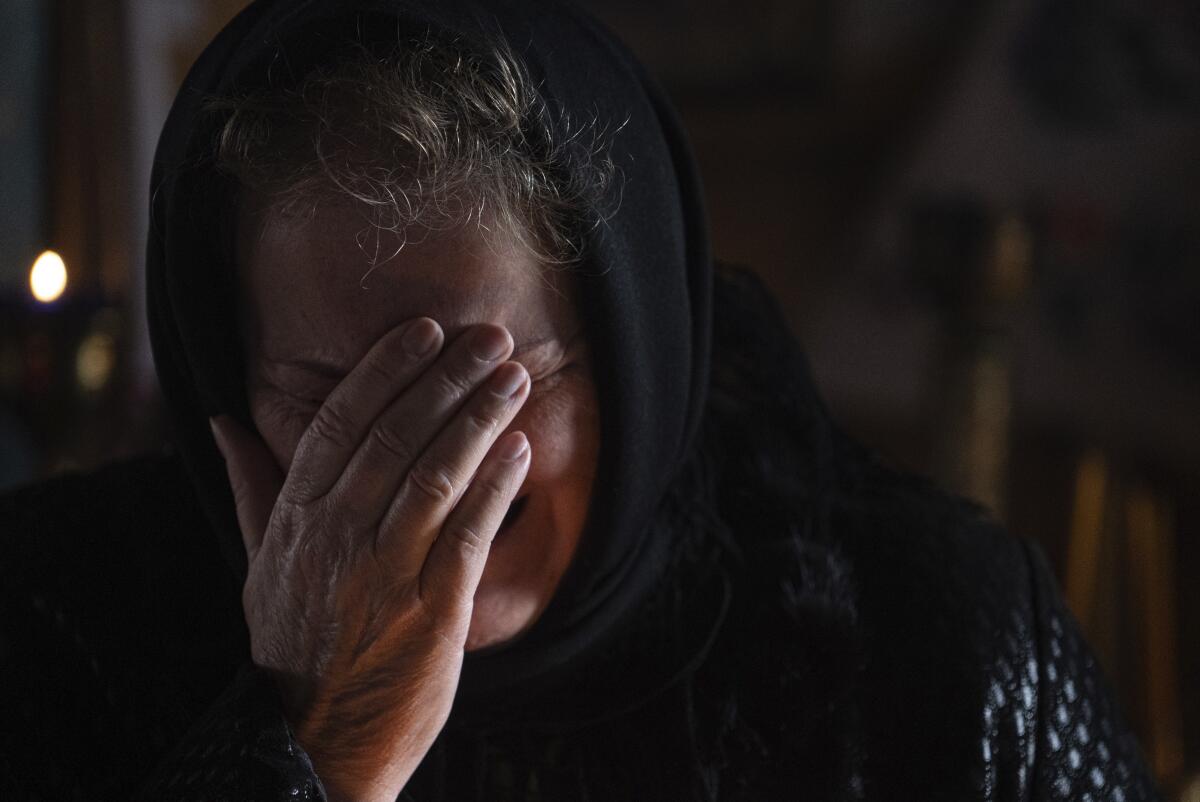
About a mile away, the blackened hulks of apartment blocks loom over Chornovola Street.
It appears that Russian bombs badly damaged at least five buildings — home to about 2,000 people — that included several drab, Soviet-era structures and one modern 17-story tower.
Most of the windows were blown out. Concrete facades had plunged to the ground, revealing the shattered remains of living quarters. A deep bomb crater marred a grassy lawn.
Ivanov, the regional official, said at least 50 people died along Chornovola Street, while others remain missing, including a man who was visiting his wife at a cardiac care clinic when ordnance fell from the sky. The wife survived.
“We haven’t finished removing all the rubble,” Ivanov said, surveying a pile of broken concrete, shattered masonry and other debris. “There could be more bodies.”
Amid rumors Monday afternoon that another had been found, an emergency worker lugging a plastic stretcher rushed inside one of the stricken buildings. It seemed to be a false alarm.
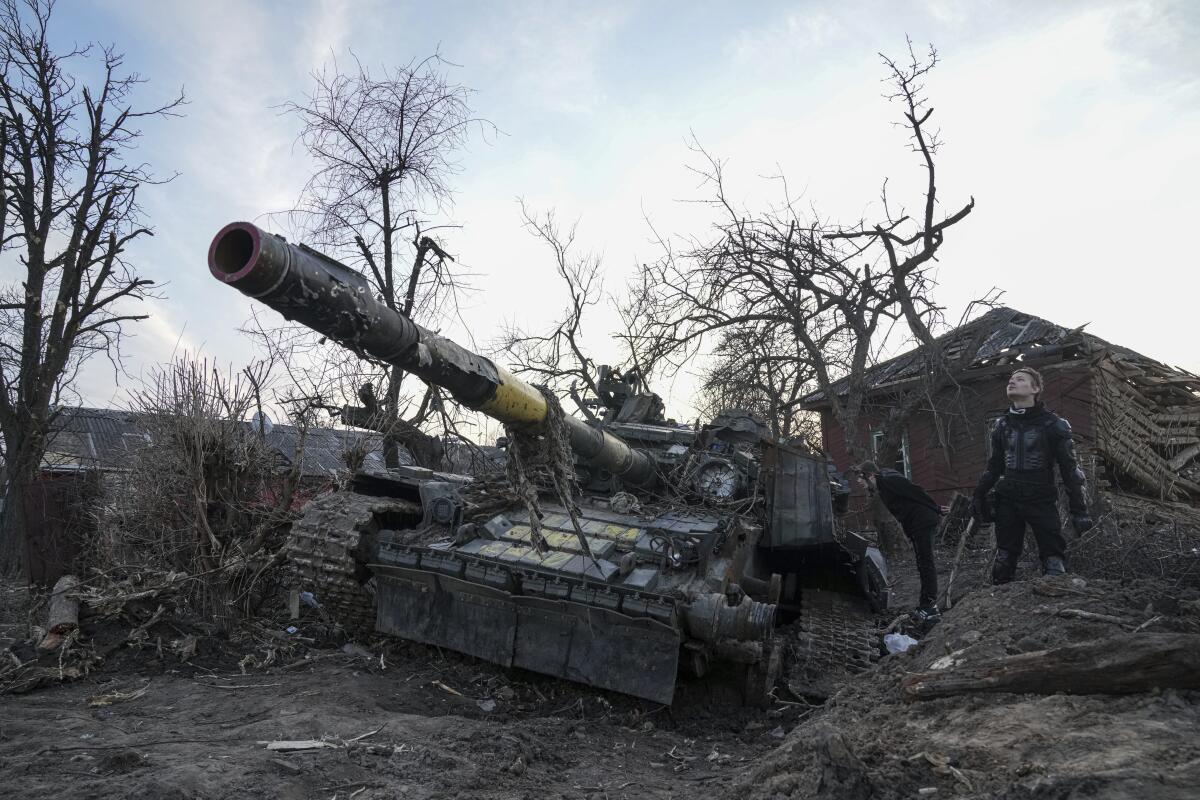
Artiukh, one of the few people who were out in the once-bustling neighborhood, was returning from her job doing cleaning. She still lives in her damaged first-floor apartment, despite having no electricity or gas.
At about noon on March 3, Artiukh recalled, she and her son were planning to leave the apartment to go for a walk. But her son had second thoughts. The Russians had already been attacking for a week.
“Let’s go to the basement,” he said.
Since the Russian invasion, basements have served as second homes for millions of Ukrainians, offering some protection from bombardment.
While sheltering on March 3, Artiukh said she heard five or six explosions. The concussions shook the building. She and her son emerged to a hellish scene.
That was more than a month ago. Now she shuffled back in the direction of her home, past the debris pile, the bomb crater and the mangled apartment towers. She hardly took notice.
More to Read
Sign up for Essential California
The most important California stories and recommendations in your inbox every morning.
You may occasionally receive promotional content from the Los Angeles Times.
